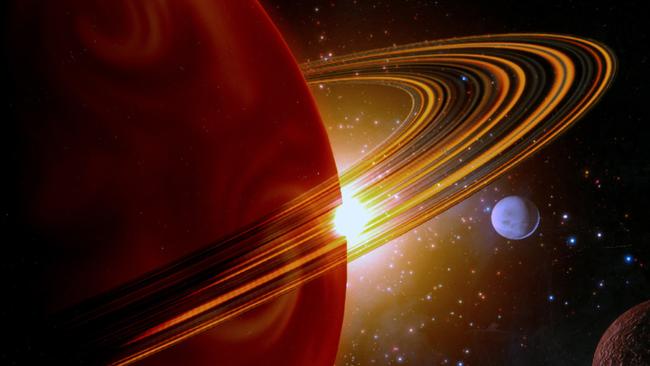Astronomers discover giant ringed planet 200 times size of Saturn
ASTRONOMERS have discovered the first-ever ringed planet beyond our solar system, an enormous celestial body 200 times the size of Saturn.

ASTRONOMERS say they have found the first-ever ringed planet beyond our solar system, a super-world with a girdle of halos 200 times bigger than Saturn’s.
Called J1407b, the giant has a disk of 30-odd rings which is so vast that, had it been around Saturn, it would have dominated our night sky, the proud discoverers said.
“It’d be huge! You’d see the rings and the gaps in the rings quite easily from Earth,” Matthew Kenworthy of the Leiden Observatory in The Netherlands said on Wednesday.
“It’d be several times the size of the full Moon.”
Kenworthy and Eric Mamajec of New York’s University of Rochester trawled through a database of millions of stars photographed by telescopes around the world in an exoplanet search project called SuperWASP.
SPACE MYSTERY: Has the ‘magic island’ mystery on Saturn’s moon Titan been solved?
SPACE ODDITY: It’s raining diamonds on Saturn and Jupiter say scientists

Exoplanets, worlds beyond our own Solar System, are observed from Earth through changes in the brightness of their central star.
Kenworthy said the planet itself was probably about 10 to 40 times the mass of Jupiter, the biggest planet of our star system.
The planet’s rings begin at a distance of about 30 million kilometres from the planet and stretch out to a distance of 90 million kilometres.
And they are probably made of dust, as planet J1407b is too hot to support ice rings like those orbiting Saturn.
J1407 and its planet are about 16 million years old, which makes it an infant in terms of stellar age. The Sun and Earth are some 4.5 billion years old.
Kenworthy said the find provided the first direct evidence for theories about planetary ring formation.
It is widely held that big clouds of gas and dust collapse to form stars orbited by a thick disk of debris.
The research has been accepted for publication by the Astrophysical Journal.



